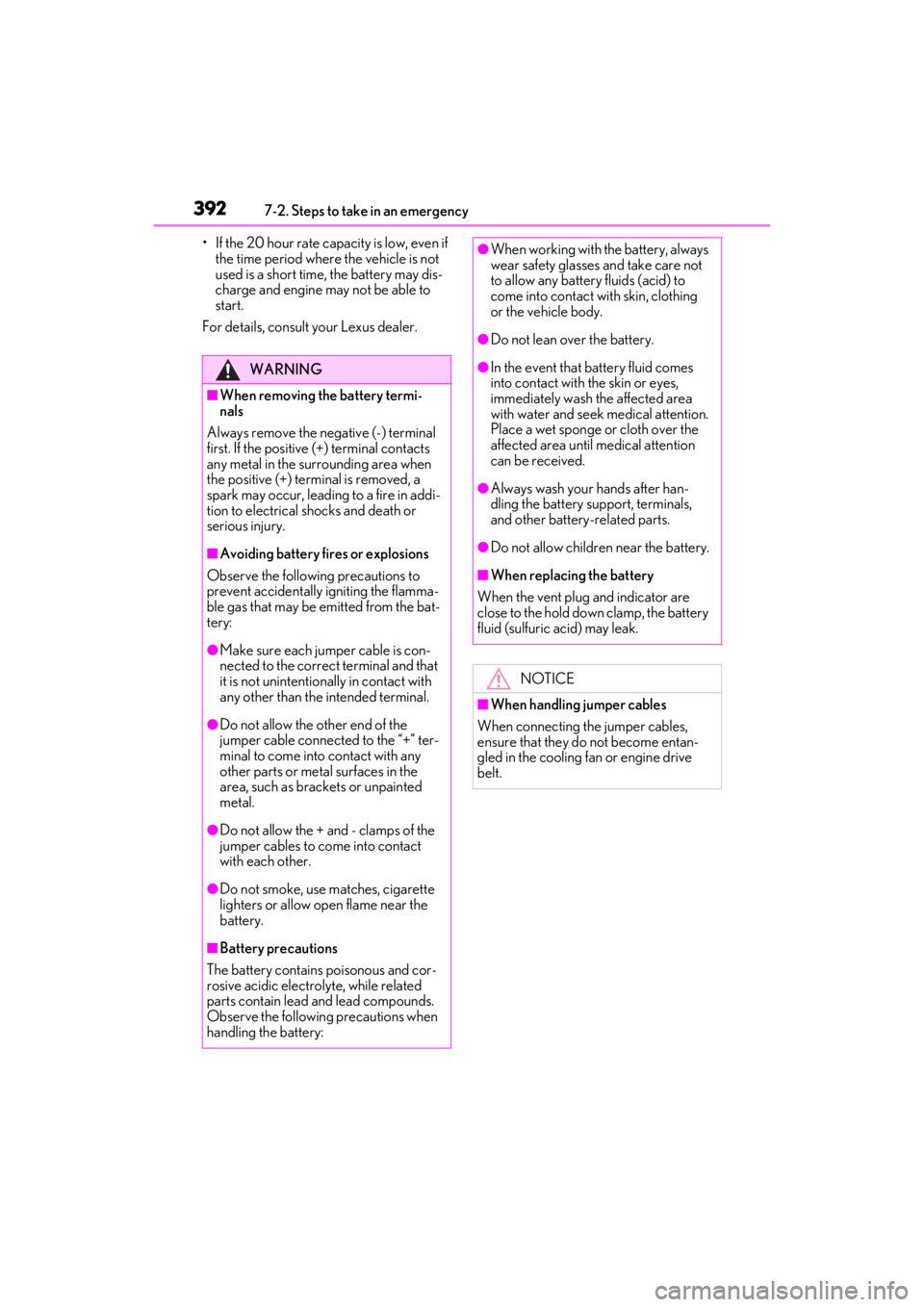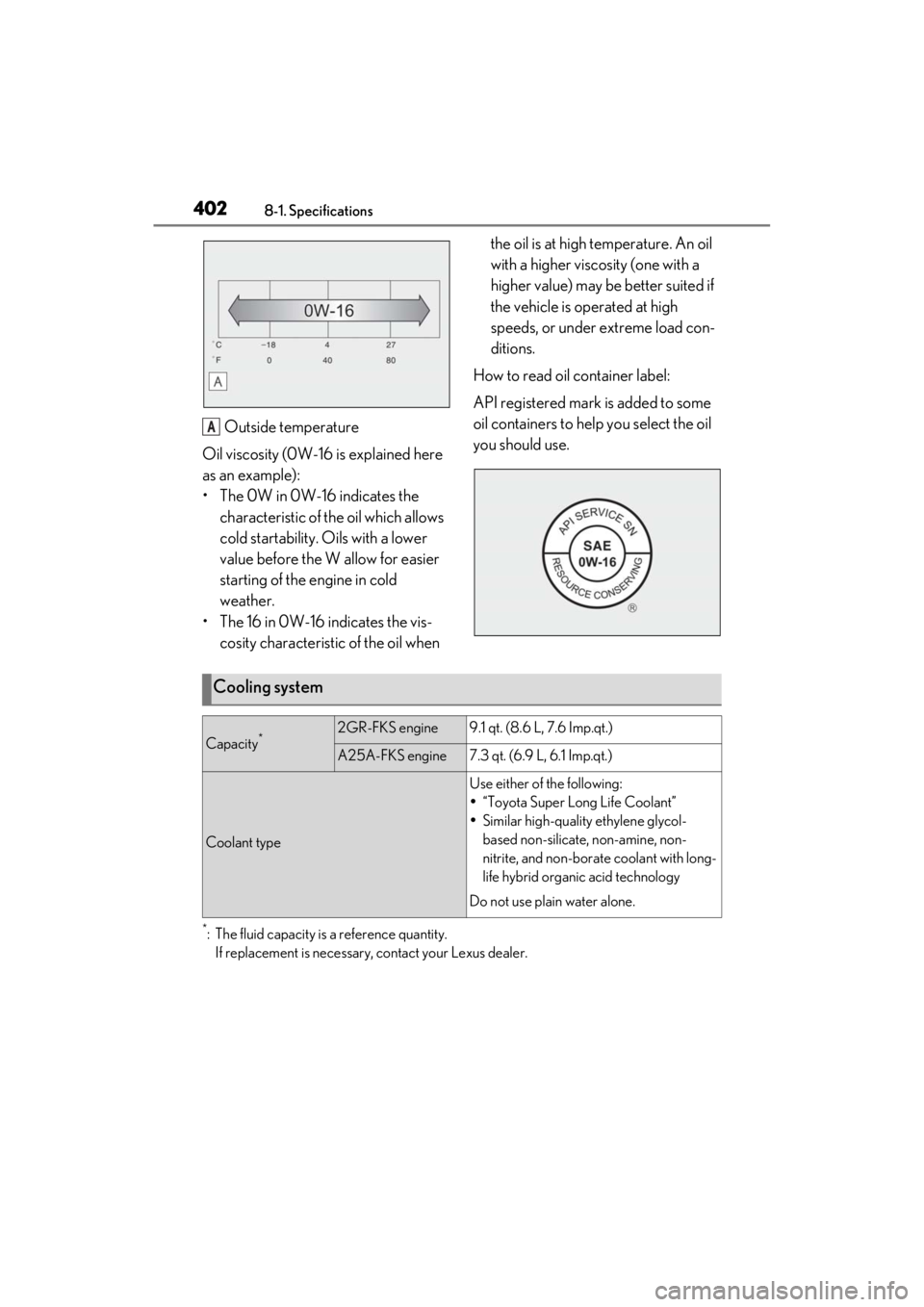2021 LEXUS ES350 cooling
[x] Cancel search: coolingPage 322 of 464

3226-3. Do-it-yourself maintenance
The coolant level is satisfactory if it is
between the “F” and “L” lines on the
reservoir when the engine is cold.Reservoir cap
“F” line
“L” line
If the level is on or below the “L” line, add
coolant up to the “F” line. ( P.393)
■Coolant selection
Only use “Toyota Super Long Life Coolant”
or a similar high quality ethylene glycol
based non-silicate, non-amine, non-nitrite,
and non-borate coolant with long-life
hybrid organic acid technology.
U.S.A.:
“Toyota Super Long Life Coolant” is a mix-
ture of 50% coolant and 50% deionized
water. (Minimum temperature: -31°F [-
35°C])
Canada:
“Toyota Super Long Life Coolant” is a mix-
ture of 55% coolant and 45% deionized
water. (Minimum temperature: -44°F [-
42°C])
For more details about engine coolant, con-
tact your Lexus dealer.
■If the coolant level drops within a short
time of replenishing
Visually check the radi ator, hoses, engine
coolant reservoir cap, drain cock and water
pump.
If you cannot find a leak, have your Lexus
dealer test the cap and check for leaks in
the cooling system.
Check the radiator and condenser and
clear away any foreign objects.
If either of the above parts is extremely
dirty or you are not sure of their condi-
tion, have your vehicle inspected by
your Lexus dealer.
NOTICE
●Be sure the engine oi l filler cap is prop-
erly tightened.
Checking the engine coolant
A
B
C
WARNING
■When the engine is hot
Do not remove the engine coolant reser-
voir cap or the radiator cap. ( P.394)
The cooling system may be under pres-
sure and may spray hot coolant if the cap
is removed, causing serious injuries, such
as burns.
NOTICE
■When adding coolant
Coolant is neithe r plain water nor
straight antifreeze. The correct mixture
of water and antifreeze must be used to
provide proper lubrication, corrosion
protection and cooling. Be sure to read
the antifreeze or coolant label.
■If you spill coolant
Be sure to wash it off with water to pre-
vent it from damaging parts or paint.
Checking the radiator and con-
denser
Page 392 of 464

3927-2. Steps to take in an emergency
• If the 20 hour rate capacity is low, even if the time period where the vehicle is not
used is a short time, the battery may dis-
charge and engine may not be able to
start.
For details, consult your Lexus dealer.
WARNING
■When removing the battery termi-
nals
Always remove the negative (-) terminal
first. If the positive (+) terminal contacts
any metal in the surrounding area when
the positive (+) terminal is removed, a
spark may occur, leading to a fire in addi-
tion to electrical shocks and death or
serious injury.
■Avoiding battery fires or explosions
Observe the following precautions to
prevent accidentally igniting the flamma-
ble gas that may be emitted from the bat-
tery:
●Make sure each jumper cable is con-
nected to the correct terminal and that
it is not unintentiona lly in contact with
any other than the intended terminal.
●Do not allow the other end of the
jumper cable connected to the “+” ter-
minal to come into contact with any
other parts or metal surfaces in the
area, such as brackets or unpainted
metal.
●Do not allow the + and - clamps of the
jumper cables to come into contact
with each other.
●Do not smoke, use matches, cigarette
lighters or allow open flame near the
battery.
■Battery precautions
The battery contains poisonous and cor-
rosive acidic electrolyte, while related
parts contain lead and lead compounds.
Observe the following precautions when
handling the battery:
●When working with the battery, always
wear safety glasses and take care not
to allow any battery fluids (acid) to
come into contact with skin, clothing
or the vehicle body.
●Do not lean over the battery.
●In the event that battery fluid comes
into contact with the skin or eyes,
immediately wash the affected area
with water and seek medical attention.
Place a wet sponge or cloth over the
affected area until medical attention
can be received.
●Always wash your hands after han-
dling the battery support, terminals,
and other battery-related parts.
●Do not allow children near the battery.
■When replacing the battery
When the vent plug and indicator are
close to the hold down clamp, the battery
fluid (sulfuric acid) may leak.
NOTICE
■When handling jumper cables
When connecting the jumper cables,
ensure that they do not become entan-
gled in the cooling fan or engine drive
belt.
Page 393 of 464

3937-2. Steps to take in an emergency
7
When trouble arises
1Stop the vehicle in a safe place and
turn off the air conditioning system,
and then stop the engine.
2 If you see steam:
Carefully lift the hood after the
steam subsides.
If you do not see steam:
Carefully lift the hood.
3 After the engine has cooled down
sufficiently, inspect the hoses and radiator core (radiator) for any
leaks.
Radiator
Cooling fan
If a large amount of coolant leaks, immedi-
ately contact your Lexus dealer.
4
The coolant level is satisfactory if it
is between the “F” and “L” lines on
the reservoir.
2GR-FKS engine
Reservoir
“F” line
“L” line
Coolant inlet cap
If your vehicle overheats
The following may indicate that
your vehicle is overheating.
The engine coolant temperature
gauge ( P.70, 73) is in the red
zone or a loss of engine power is
experienced. (For example, the
vehicle speed does not increase.)
“Engine Coolant Temp High Stop
in a Safe Place See Owner’s
Manual” is shown on the multi-
information display.
Steam comes out from under the
hood.
Correction procedures
A
B
A
B
C
D
Page 394 of 464

3947-2. Steps to take in an emergency
A25A-FKS engineReservoir
“F” line
“L” line
Coolant inlet cap
5 Add coolant if necessary.
2GR-FKS engine
Water can be used in an emergency if
coolant is unavailable.
A25A-FKS engine
Water can be used in an emergency if
coolant is unavailable.
6Start the engine and turn the air
conditioning system on to check
that the radiator cooling fan oper-
ates and to check for coolant leaks
from the radiator or hoses.
The fan operates when the air conditioning
system is turned on immediately after a
cold start. Confirm that the fan is operating
by checking the fan sound and air flow. If it
is difficult to check these, turn the air con-
ditioning system on and off repeatedly.
(The fan may not oper ate in freezing tem-
peratures.)
7 If the fan is not operating:
Stop the engine immediately and
contact your Lexus dealer.
If the fan is operating:
Have the vehicle inspected at the
nearest Lexus dealer.
A
B
C
D
WARNING
■When inspecting under the hood of
your vehicle
Observe the following precautions.
Failure to do so may result in serious
injury such as burns.
●If steam is seen coming from under the
hood, do not open the hood until the
steam has subsided. The engine com-
partment may be very hot.
●Keep hands and clothing (especially a
tie, a scarf or a muffler) away from the
fan and belts. Failure to do so may
cause the hands or clothing to be
caught, resulting in serious injury.
●While the engine and radiator are hot,
do not loosen or remove the coolant
inlet cap or coolant reservoir cap.
High temperature steam or coolant
could spray out.
Page 395 of 464

3957-2. Steps to take in an emergency
7
When trouble arises
1Stop the engine. Set the parking
brake and shift the shift lever to P.
2 Remove the mud, snow or sand
from around the front wheels.
3 Place wood, stones or some other
material under the front wheels to
help provide traction.
4 Restart the engine.
5 Shift the shift lever to D or R and
release the parking brake. Then,
while exercising caution, depress
the accelerator pedal.
■When it is difficult to free the vehicle
Press the switch to turn off TRAC.
NOTICE
■When adding engine coolant
Add coolant slowly after the engine has
cooled down sufficiently. Adding cool
coolant to a hot engine too quickly can
cause damage to the engine.
■To prevent damage to the cooling
system
Observe the following precautions:
●Avoid contaminating the coolant with
foreign matter (such as sand or dust
etc.).
●Do not use any coolant additive.
If the vehicle becomes stuck
Carry out the following procedures
if the tires spin or the vehicle
becomes stuck in mud, dirt or snow:
Recovering procedure
Page 402 of 464

4028-1. Specifications
Outside temperature
Oil viscosity (0W-16 is explained here
as an example):
• The 0W in 0W-16 indicates the characteristic of the oil which allows
cold startability. Oils with a lower
value before the W allow for easier
starting of the engine in cold
weather.
• The 16 in 0W-16 indicates the vis- cosity characteristic of the oil when the oil is at high temperature. An oil
with a higher viscosity (one with a
higher value) may be better suited if
the vehicle is operated at high
speeds, or under extreme load con-
ditions.
How to read oil container label:
API registered mark is added to some
oil containers to help you select the oil
you should use.
*: The fluid capacity is a reference quantity. If replacement is necessary, contact your Lexus dealer.
A
Cooling system
Capacity*2GR-FKS engine9.1 qt. (8.6 L, 7.6 Imp.qt.)
A25A-FKS engine7.3 qt. (6.9 L, 6.1 Imp.qt.)
Coolant type
Use either of the following:
“Toyota Super Long Life Coolant”
Similar high-quality ethylene glycol-
based non-silicate, non-amine, non-
nitrite, and non-borate coolant with long-
life hybrid organic acid technology
Do not use plain water alone.
Page 450 of 464

450Alphabetical index
C
Care ...................................................... 304, 307Aluminum wheels ......................................304
Exterior ...........................................................304
Interior ............................................................. 307
Seat belts........................................................ 307
Cargo capacity................................................ 141
Cargo hooks .................................................280
Center Display ............................................. 256
Chains .............................................................. 252
Child-protectors............................................. 98
Child restraint system................................... 43 Fixed with a LATCH system ..................50
Fixed with a seat belt....................................47
Front passenger occupant classification system ..............................................................37
Points to remember .................................... 43
Riding with children ..................................... 43
Types of child restraint system installation method ........................................................... 44
Using an anchor bracket .......................... 53
Child safety ....................................................... 43 Airbag precautions...................................... 33
Battery precautions ...................... 324, 392
Child restraint system................................. 44
Heated steering wheel and seat heater precautions................................................ 270
How your child should wear the seat belt ............................................................................ 25
Moon roof precautions ............................ 127
Panoramic moon roof precautions ..... 131
Power window lock switch.....................125
Power window precautions ...................125
Rear door child-protectors ..................... 98
Seat belt extender precautions ............. 25
Seat belt precautions ...................................24
Trunk precautions ........................................ 99
Cleaning.............................................. 304, 307 Aluminum wheels ......................................304
Exterior ...........................................................304
Interior ............................................................. 307 Radar sensor ........
............................... 171, 207
Seat belts ........................................................307
Clock ................................................. 70, 73, 281
Coat hooks..................................................... 292
Compass ......................................................... 299
Condenser ..................................................... 322
Console box .................................................. 278
Console box light ........................................ 278
Cooling system............................................. 322 Engine overheating...................................393
Cornering lights ............................................ 160 Replacing light bulbs ................................346
Cruise control Dynamic radar cruise control with full-
speed range ............................................... 195
Cup holder ..................................................... 278
Current fuel consumption ...........................79
Curtain shield airbags .................................. 28
Customizable features ................................419
D
Daytime running light system .................. 158
Defogger Outside rear view mirrors..................... 264
Rear window ................................................ 264
Windshield .................................................... 264
Dimension ...................................................... 398
Dinghy towing................................................. 142
Display BSM (Blind Spot Monitor)................... 205
Dynamic radar cruise control with full-
speed range ............................................... 195
Head-up display............................................84
Intuitive parking assist ................................213
LTA (Lane Tracing Assist) ..................... 189
Multi-information display ...........................77
Parking Support Brake function (rear pedestrians)............................................... 243
RCD (Rear Camera Detection) ........ 224
RCTA...............................................................220
Warning message .......................................371
Distance until next engine oil